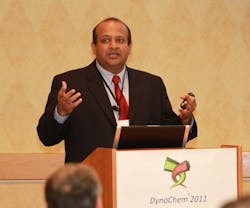He touched upon product design outside the pharmaceutical industry—and some of the factors that have led other industries to significantly accelerate product design tools and efforts within short time frames. Pharma will need to do this, he pointed out. “Our Moore’s Law” is upon us, he said, referring to looming patent expirations and the impact that subsequent losses of billions of dollars of revenue will have.
As a result, improved product design and the use of advanced product design tools will be critical. “The key question is,” he said, “are these attempts to optimize products in silos? What is the global design?”
“CMC teams tend to do this optimization in their heads,” he added. “What we are trying to propose is, can we predict outcomes so there is less iteration and more assurance of success? We hope we can provide directionality at an early stage to avoid costly redesign.”
Viswanath emphasized the importance of a modeling approach which integrates manufacturability concerns with those of bioavailability and stability. The right time for such integrated product design work varies on a case by case basis, but a good time, generally, is between FHD and the Proof of Concept phases.
Viswanath then presented an example of how a manufacturer might choose between two salts for an API. The challenge, he said, requires developing equations for bioavailability, stability, and manufacturability and solving them simultaneously, in order to develop a “response surface” and receive thorough “directionality on where we should focus our efforts.”
In closing, Viswanath noted that there are many additional modeling opportunities that product design teams can avail themselves of—to, for example, help increase rigor for particle size distribution or better define manufacturability. The influence of process modeling has shaped critical thinking in drug process development in the last two to three decades. “If these same minds were to address the current product design problems, miracles could happen.”
May 11, at the DynoChem 2011 North American users group in Rosemont, Illinois, Eli Lilly’s Shekhar Viswanath, PhD, presented on his company’s efforts to expand the scope of modeling in drug product design. Viswanath, who leads the PAT and modeling group in chemical process development in Indianapolis, emphasized the need for pharma’s engineers to become as competent in “product modeling” as they have become in process modeling.






